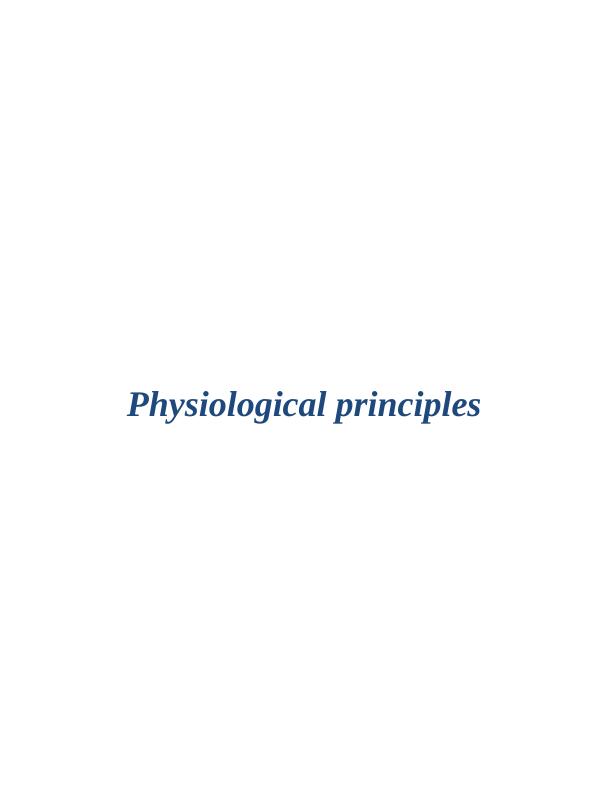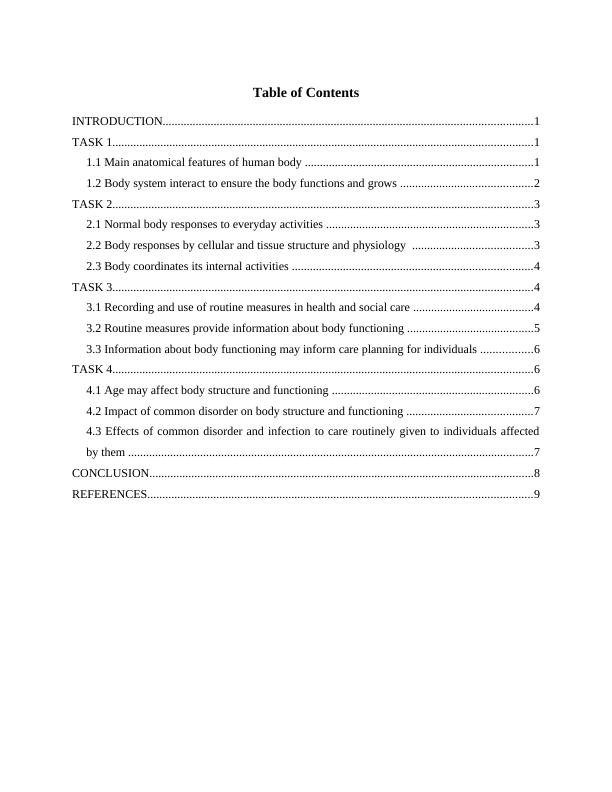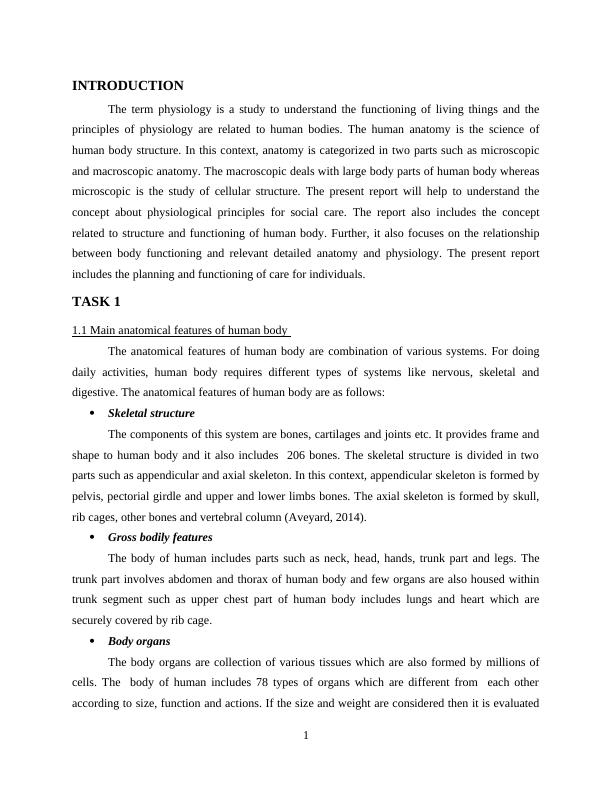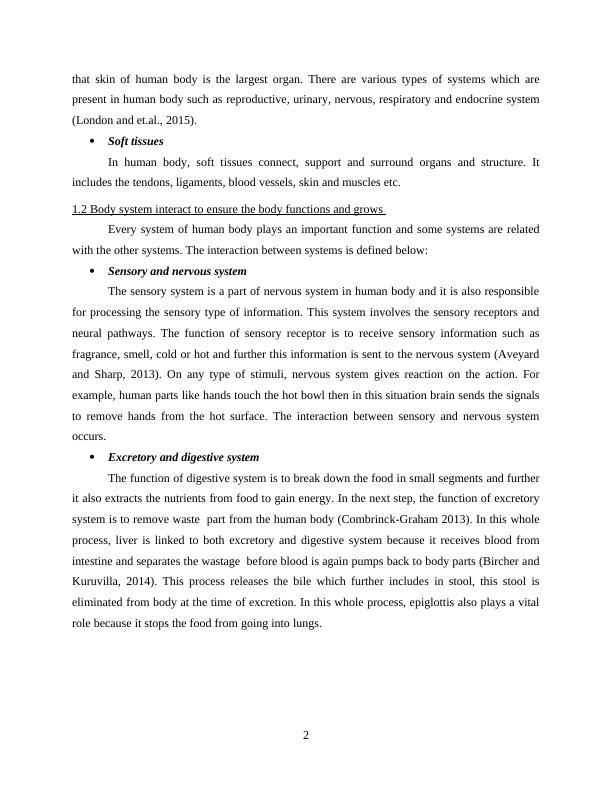Physiological Principles for Social Care : Report
12 Pages3993 Words213 Views
Added on 2020-01-15
Physiological Principles for Social Care : Report
Added on 2020-01-15
ShareRelated Documents
Physiological principles

Table of ContentsINTRODUCTION...........................................................................................................................1TASK 1............................................................................................................................................11.1 Main anatomical features of human body ............................................................................11.2 Body system interact to ensure the body functions and grows ............................................2TASK 2............................................................................................................................................32.1 Normal body responses to everyday activities .....................................................................32.2 Body responses by cellular and tissue structure and physiology ........................................32.3 Body coordinates its internal activities ................................................................................4TASK 3............................................................................................................................................43.1 Recording and use of routine measures in health and social care ........................................43.2 Routine measures provide information about body functioning ..........................................53.3 Information about body functioning may inform care planning for individuals .................6TASK 4............................................................................................................................................64.1 Age may affect body structure and functioning ...................................................................64.2 Impact of common disorder on body structure and functioning ..........................................74.3 Effects of common disorder and infection to care routinely given to individuals affectedby them .......................................................................................................................................7CONCLUSION................................................................................................................................8REFERENCES................................................................................................................................9

INTRODUCTIONThe term physiology is a study to understand the functioning of living things and theprinciples of physiology are related to human bodies. The human anatomy is the science ofhuman body structure. In this context, anatomy is categorized in two parts such as microscopicand macroscopic anatomy. The macroscopic deals with large body parts of human body whereasmicroscopic is the study of cellular structure. The present report will help to understand theconcept about physiological principles for social care. The report also includes the conceptrelated to structure and functioning of human body. Further, it also focuses on the relationshipbetween body functioning and relevant detailed anatomy and physiology. The present reportincludes the planning and functioning of care for individuals.TASK 11.1 Main anatomical features of human body The anatomical features of human body are combination of various systems. For doingdaily activities, human body requires different types of systems like nervous, skeletal anddigestive. The anatomical features of human body are as follows:Skeletal structureThe components of this system are bones, cartilages and joints etc. It provides frame andshape to human body and it also includes 206 bones. The skeletal structure is divided in twoparts such as appendicular and axial skeleton. In this context, appendicular skeleton is formed bypelvis, pectorial girdle and upper and lower limbs bones. The axial skeleton is formed by skull,rib cages, other bones and vertebral column (Aveyard, 2014).Gross bodily featuresThe body of human includes parts such as neck, head, hands, trunk part and legs. Thetrunk part involves abdomen and thorax of human body and few organs are also housed withintrunk segment such as upper chest part of human body includes lungs and heart which aresecurely covered by rib cage. Body organsThe body organs are collection of various tissues which are also formed by millions ofcells. The body of human includes 78 types of organs which are different from each otheraccording to size, function and actions. If the size and weight are considered then it is evaluated1

that skin of human body is the largest organ. There are various types of systems which arepresent in human body such as reproductive, urinary, nervous, respiratory and endocrine system(London and et.al., 2015).Soft tissuesIn human body, soft tissues connect, support and surround organs and structure. Itincludes the tendons, ligaments, blood vessels, skin and muscles etc.1.2 Body system interact to ensure the body functions and grows Every system of human body plays an important function and some systems are relatedwith the other systems. The interaction between systems is defined below:Sensory and nervous systemThe sensory system is a part of nervous system in human body and it is also responsiblefor processing the sensory type of information. This system involves the sensory receptors andneural pathways. The function of sensory receptor is to receive sensory information such asfragrance, smell, cold or hot and further this information is sent to the nervous system (Aveyardand Sharp, 2013). On any type of stimuli, nervous system gives reaction on the action. Forexample, human parts like hands touch the hot bowl then in this situation brain sends the signalsto remove hands from the hot surface. The interaction between sensory and nervous systemoccurs. Excretory and digestive systemThe function of digestive system is to break down the food in small segments and furtherit also extracts the nutrients from food to gain energy. In the next step, the function of excretorysystem is to remove waste part from the human body (Combrinck-Graham 2013). In this wholeprocess, liver is linked to both excretory and digestive system because it receives blood fromintestine and separates the wastage before blood is again pumps back to body parts (Bircher andKuruvilla, 2014). This process releases the bile which further includes in stool, this stool iseliminated from body at the time of excretion. In this whole process, epiglottis also plays a vitalrole because it stops the food from going into lungs.2

End of preview
Want to access all the pages? Upload your documents or become a member.
Related Documents
Physiological Principles of Health and Social Carelg...
|14
|4291
|361
Physiological Principles Of Human Body Reportlg...
|15
|4074
|474
Physiological Principles for Health and Social Care Reportlg...
|17
|4802
|180
Physiological Principles for Health and Social Care Doclg...
|20
|6332
|342
Physiological Principles for Health and Social Carelg...
|14
|5274
|475
Skeletal and Muscular System PDFlg...
|9
|2257
|350
